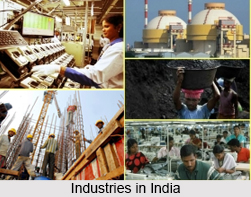 Industries in India are major aspects of rapid growth in modern India. Industry is a manufacturing unit or a commercial unit that produce the goods and services for the people. Industries are for economic and business purpose. Therefore, Industries in India affects the Gross Domestic Product (GDP) and play a vital role in Indian economy. India is basically an agrarian nation, but Indian industries provide financial support to the country.
Industries in India are major aspects of rapid growth in modern India. Industry is a manufacturing unit or a commercial unit that produce the goods and services for the people. Industries are for economic and business purpose. Therefore, Industries in India affects the Gross Domestic Product (GDP) and play a vital role in Indian economy. India is basically an agrarian nation, but Indian industries provide financial support to the country.
After independence, India successfully achieved sovereignty in manufacturing various products. Amongst the various Indian Industries, the most notable ones are involved in the generation of power and transmission, production of heavy electrical equipments, computers, aircrafts, automobiles, vessels, steam engines, chemicals, construction machinery, communication instruments and precision equipments and tools.
History of Industries in India
In India, the concept of industries was introduced during British rule in the country. During the period from the late 18th to the early 19th centuries, a radical change in agriculture, manufacturing, production and transportation took place. The inception of Industries in India influenced the socio-economic and cultural conditions in the subcontinent. The onset of industrial revolution marked a major turning point in Indian society. The establishment of tea industry is known to mark the beginning of industrial development in India.
 Sections of Industries in India
Sections of Industries in India
In India, three key industrial sectors exist, based on the type of business activities conducted in a work setting. They are:
•The primary sector is largely involved in extracting raw materials. Mining and farming industries belong to primary sector.
•The secondary sector is associated with refining, construction and manufacturing.
•The tertiary sector deals in distribution of manufactured goods and providing services.
Types of Industries in India
Types of Industries in India can broadly be divided into large scale industries and small scale industries. Large scale industries involve huge infrastructure, man power and have an influx of capital assets. The heavy industries of India include iron and steel industry, textile industry, leather industry, automobile industry, cement industry, diamond industry, food industry, etc. Petrochemicals in India significantly affect fiscal planning in the country. Mining Industry is also amongst the key Indian industries and provides occupation to almost 0.7 million people across the country. India is greatly dependent on large industries for economic growth, generation of foreign currency and for providing job opportunities. Large scale industries make urbanization desirable in the society.
However, small-scale industries also contribute to the GDP of India. They are termed as traditional sectors and have huge growth prospect. The primary concern of the small-scale industries is that the capital resources are invested for the development of machineries.
Other Industries in India
Indian Film Industry is regarded as a major industry that has developed to a great extent in the recent years. With the advent of major corporate houses in the sector, the investment in film making has also increased. The Indian film industry has become one of the major contributors to the Indian economy. Indian Software Industry witnessed a massive boom and gave the label of a knowledge based economy to the country. This industry has been growing rapidly in the recent times with increase in outsourced projects. The industries such as Indian Chemical Industry and Indian Vegetable Oil Industry are also known to contribute to the country"s growth.















